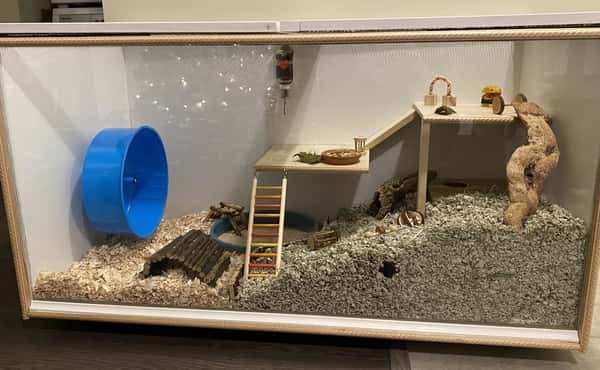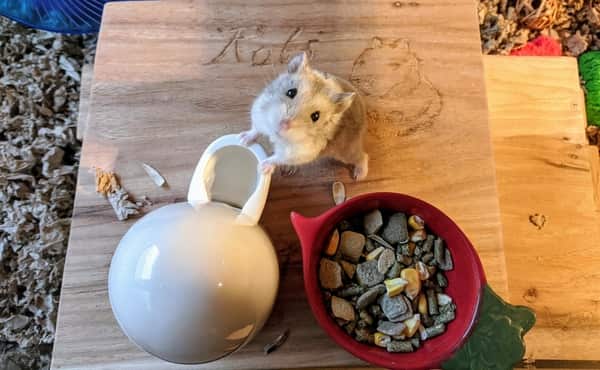Like most animals, hamsters have a unique way of communicating with one another. You may see them stick their noses up at each other when first meeting, or maybe they will circle each other to get an idea of what the other is like. When things start to get rough though, you may wonder why they dislike each other suddenly and what you can do to fix the issues.
So, why are my hamsters fighting all of a sudden? There are many reasons why hamsters may fight each other including, but not limited to, space issues, breed type and sex, and sanitary problems within their cage.
In this article, we will discuss the reasons behind why your hamsters may be fighting and what you as an owner can do to resolve their fighting and restore the peace between your dear pets.

Space Required When Owning More Than One Hamster
When you buy your first hamster, it is easy to find a cage that is big enough for it to comfortably play, run around, and relax. When you buy a second one though, it is important to keep in mind that they both need equal amounts of space in order to play independently and have their own space when needed.
For one hamster, your cage should be at least 15 inches long and 12 inches high. This gives the hamster the space it needs to lead a happy and healthy life. When you are adding a second hamster to one cage, you should more than likely double that size, if possible.
If that is not doable, then increasing the original cage size by half should give you more room, but you will want to keep an eye on your hamsters and give them individual space to play and roam frequently.
If you have a hamster ball, it may be a good idea to, every day, allow one hamster at a time to play in the hamster ball while the other plays in the cage so both hamsters are able to get time independently to play and relax.
Toys, Food, and Resting Spots
When owning more than one hamster, it is also important that you have enough toys, food, and spots to rest so that your hamsters are not always on top of one another when wanting to play, eat, or sleep.
This could include putting an array of options for toys in the hamster cage, so they have many options to choose from. You could have two hamster wheels, climbing equipment, tubing for your hamsters to play in, or small toys for them to chew on.
You should also have two food bowls and two water bottles so they do not fight when eating or drinking and have two areas for your hamsters to sleep so they can rest quietly.
If you are someone that has a sibling, or multiple siblings, then you know how important it is to have your own space, or at least your own bed. Nobody wants to spend every moment of every day together and giving your hamsters different areas to sleep will allow them to get space from their hamster sibling when needed.
The Breed and Sex of Your Hamster
There are some breeds of hamsters that should not have a roommate in their cages. Two examples of hamsters that should not be housed together are Syrian and Chinese hamsters. These two breeds of hamsters of solitary creatures and they can get very territorial.
This means that they enjoy having their own space and will get incredibly angry if their space is taken up by someone else.
These two breeds also only meet a hamster of the same breed when they need to mate. Other than that, they live alone while in the wild and it should be kept that way when living domestically if you want to keep the peace between your pets.
It is also important that you do not house two male hamsters together. Because these hamsters are of the same sex, they are less likely to get along with each other compared to if they were housed with a hamster of the opposite sex due to the need for dominace.
Keeping Your Hamster’s Cage Clean and Sanitary
Would you want to live in your house if it was not cleaned regularly? Would you sleep on your bed if it was wet or dirty? Probably not. Your hamster feels the same way. It is important to regularly clean your hamster’s cage for their wellbeing.
If you have more than one hamster in a cage, it is important to keep it clean so they are able to enjoy all of the space given to them without avoiding certain areas that may be dirty.
The smell of a dirty cage can also be stressful to your hamsters. When under stress, hamsters are more likely to fight with one another and this is exactly what we are trying to avoid.
How Often Should You Clean Your Hamster’s Cage?
At the minimum, you should be cleaning your hamster’s cage once every week. Ideally, a hamster’s cage should be spot cleaned every day to make sure toys are clean, bedding is dry, and food bowls are clear of debris or feces.
Steps to take when cleaning your hamster’s cage:
– Remove your hamster: This one should be an obvious step. When cleaning the cage, you will want your hamster out of the way and safely put in an area where it will not be able to escape since you will have the cage wide open while cleaning it.
– Remove everything out of the cage: You should remove old bedding, toys, equipment, food bowls, and water bottles. The old bedding should be tied up and thrown away and all old food or water should be disposed of and replaced with new food and fresh water.
– Wash all items: After you remove everything out of your hamster’s cage, you should sanitize everything that was not thrown away, including food bowls, water bottles, equipment, and toys. Make sure that you clean inside and outside of everything and make sure everything is dry before returning it to the cage.
– Sanitize the cage itself: Because the bedding and littler could have been soiled, you will want to clean the cage as well with warm soapy water and dried before setting everything back up.
What Do I Do if None of This Works?
Have you tried all the steps listed above but your hamsters still fight? The final solution is to just get another cage and allow your hamsters to live separately. Like humans, some hamsters just prefer to live alone, and this is okay. It will be less stressful on your hamsters and less stressful on you.
Now, this does not mean that your hamsters cannot play together occasionally. Maybe you can keep the larger cage and just use it for play dates to allow your hamsters to socialize. Or you can invest in a small fencing system to set up and allow your hamsters to roam around together there.
Just because they may not enjoy living together, does not mean they will not want to socialize with one another a couple times a week.
If you cannot afford a second cage, it may be best to rehome one of your hamsters by giving it to one of your friends or a close family member; this way, your two hamsters can still socialize and you will always get to hang out with both hamsters when you want to, just without all the stress of keeping both pets happy.
Conclusion
So, what have we learned about why our hamsters are fighting? Firstly, they may not have enough space for both hamsters to live happily. They could also be breeds that prefer solidarity or male and female hamsters that only meet to mate.
Or maybe your hamster cage just needs a really nice deep cleaning in order to remove stress from your hamsters’ lives. Overall, there are many reasons why your hamsters are not getting along and things you can do in order to improve the relationship between your hamsters.
If none of these tips resolve the issues between your hamsters, your next best option is to separate them and allow them to live in different cages so they can have their own private space while still having a friend to play with every once in a while.
Hamsters are just like humans. While having another hamster around can be fun, not having enough space to being around them too often can be stressful and ruin their relationship. It is important to do whatever you can to make sure your hamsters are happy and healthy.




